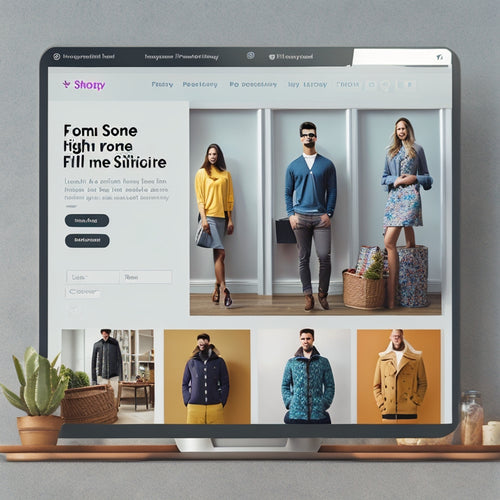
7 Tips to Seamlessly Integrate Online Courses
Share
You're about to take your online course integration to the next level. To create a seamless learning experience, start by identifying your target audience and their pain points. Then, choose a platform that aligns with your brand and goals. Next, guarantee your courses are product-centric, with practical examples and relevant assessments. Streamline the user experience with intuitive interfaces, engaging activities, and timely feedback. Leverage email marketing to promote your courses and set up a seamless checkout process. Finally, track performance metrics to refine your strategy. By implementing these tips, you'll be well on your way to driving engagement and growing your business - and that's just the beginning.
Key Takeaways
• Identify target audiences and develop content that speaks directly to their needs to increase engagement and course success.
• Choose a platform that aligns with your goals, budget, and technical expertise, considering customization, interactivity, scalability, and integration.
• Align course content with your product by highlighting its benefits, incorporating real-world examples, and designing product-centric assessments.
• Streamline the user experience by establishing intuitive interfaces, organizing courses logically, and incorporating engaging activities and interactive multimedia.
• Utilize email marketing campaigns to promote online courses, sharing valuable content, exclusive tips, and behind-the-scenes stories to reach a wider audience.
Identify Your Target Audience
When creating an online course, you need to identify your target audience to guarantee the content resonates with them and meets their needs. This involves conducting thorough customer analysis to understand their pain points, goals, and motivations. By doing so, you'll be able to create content that speaks directly to them, increasing engagement and ultimately, course success.
To effectively identify your target audience, you need to segment them based on demographics, interests, and behaviors. This audience segmentation will help you develop targeted marketing strategies that resonate with each group.
For instance, if your course is on digital marketing, you may have a segment of young entrepreneurs and another of established business owners. By understanding their unique needs and challenges, you can tailor your content and marketing approach to effectively reach and engage each group.
Choose the Right Platform
With numerous online course platforms available, you'll need to select one that aligns with your goals, budget, and technical expertise to guarantee a seamless learning experience for your target audience. This decision will have a significant impact on the overall success of your online course.
When choosing a platform, consider the following factors:
-
Customization options: Does the platform allow you to create a custom platform that reflects your brand's identity?
-
Interactive features: Does the platform offer interactive features such as quizzes, gamification, and discussion forums to engage your learners?
-
Scalability: Can the platform handle a large number of learners and courses without compromising performance?
- Integration capabilities: Does the platform seamlessly integrate with your existing tools and systems, such as CRM, LMS, or email marketing software?
Align Courses With Products
When aligning your online courses with products, you'll want to make sure that the course content directly relates to the products you're offering.
You'll need to map out the relevance of each product to the course material, making it clear how the two complement each other.
Course Content Alignment
You'll greatly enhance the learning experience by purposely aligning your online course content with your products or services. This alignment fosters content customization, allowing you to tailor your course to your audience's specific needs. As a result, you'll see increased audience engagement and user interaction, leading to a more effective learning experience.
To achieve the best possible alignment, consider the following:
-
Identify key product features: Highlight the core benefits and features of your products or services and weave them into your course content.
-
Use real-world examples: Incorporate practical, real-world scenarios that demonstrate how your products or services can be applied in different contexts.
-
Develop product-centric assessments: Design course evaluations that test learners' understanding of your products or services, ensuring they can effectively utilize them.
- Incorporate feedback mechanisms: Encourage learners to provide feedback on your products or services, allowing you to refine and improve them over time.
Product Relevance Mapping
By applying product relevance mapping, you can pinpoint the most critical aspects of your products or services and strategically integrate them into your online course content. This guarantees that your course is aligned with your product offerings, making it more relevant and valuable to your customers.
To do this, you need to identify the key features and benefits of your products and map them to specific learning objectives and outcomes in your course. This will help you create content that's highly relevant to your customers' needs and pain points.
Streamline User Experience
As you work to streamline the user experience, you'll want to focus on creating an intuitive interface that makes it easy for learners to find what they need.
You'll achieve this by establishing clear navigation paths, organizing courses in a logical structure, and incorporating consistent branding elements throughout.
Easy Navigation Paths
To streamline user experience, online course platforms must provide easy navigation paths that enable learners to quickly find and access the resources they need. This is important for boosting user engagement and encouraging learners to stay on track with their course goals.
When you're designing your online course, make sure to prioritize easy navigation paths that allow learners to effortlessly move between lessons, assignments, and other course materials.
Here are some key strategies to keep in mind:
-
Simplify your menu: Avoid cluttering your menu with too many options. Instead, focus on the most essential features and make them easily accessible.
-
Use clear labels: Use clear and descriptive labels for your navigation menus, so learners know exactly where they're going.
-
Provide a course map: Create a course map that outlines the learning path and helps learners visualize their progress.
- Make it mobile-friendly: Confirm your navigation paths are optimized for mobile devices, so learners can access your course on-the-go.
Clear Course Structure
You'll want to organize your online course into a clear structure that breaks down intricate topics into manageable chunks, making it easy for learners to follow along and stay focused. This means dividing your course into modules or lessons that build upon each other, with clear learning objectives and outcomes.
Within each module, incorporate engaging activities, such as quizzes, discussions, and group projects, to keep learners engaged and motivated. Assessment tools, like quizzes and exams, will help you assess learners' progress and understanding. Interactive multimedia, like videos and animations, can also enrich the learning experience.
To make sure learners are on track, implement feedback loops that provide timely and constructive feedback. This could be through automated grading systems or instructor feedback. By structuring your course in this way, you'll create a seamless learning experience that flows logically and keeps learners on track.
Consistent Branding Elements
Consistent branding elements, such as logos, color schemes, and typography, help create a cohesive visual identity that streamlines the user experience and reinforces your course's professional image. By maintaining visual consistency throughout your online course, you'll strengthen brand recognition and establish trust with your learners.
Here are some tips to maintain consistent branding elements in your online course:
-
Use a uniform logo placement: Display your logo in the same location on every page, such as the top-left corner, to create a sense of familiarity.
-
Stick to a restricted color palette: Choose 2-3 core colors and use them consistently throughout your course to create a cohesive look.
-
Select a typography style: Choose a font family and adhere to it to maintain visual consistency in your headings, paragraphs, and other text elements.
- Apply branding to multimedia elements: Make sure that your images, videos, and animations align with your brand's visual identity to create a seamless user experience.
Leverage Email Marketing
By building an email list and creating targeted campaigns, educators can leverage email marketing to promote their online courses and reach a wider audience. You can start by creating valuable content that resonates with your target audience, such as exclusive tips, industry insights, or behind-the-scenes stories. This will help you build trust and establish your authority in the field.
Next, develop engagement strategies to keep your subscribers hooked, such as quizzes, surveys, or interactive challenges.
To optimize your email campaigns, use A/B testing to experiment with different subject lines, CTAs, and email formats. Analyze the results to identify what works best for your audience and adjust your strategy accordingly.
Focus on conversion optimization by including clear calls-to-action, prominent course promotions, and limited-time offers to encourage sign-ups. By fine-tuning your email marketing strategy, you can drive more traffic to your online courses, increase enrollment rates, and ultimately, boost revenue.
Remember to track your metrics, refine your approach, and continuously deliver value to your subscribers to maintain a strong online presence.
Set Up Seamless Checkout
To do away with friction and increase conversions, set up a seamless checkout process that streamlines the payment experience for your online course customers. You want to make it simple for them to complete their purchase and start learning.
Here are some essential elements to include in your seamless checkout setup:
-
Simplify payment integration: Integrate a secure payment gateway that accepts multiple payment methods, such as credit cards, PayPal, or bank transfers.
-
Design a user-friendly interface: Make sure your checkout page is easy to navigate, with clear and concise instructions, and minimal fields to fill out.
-
Implement robust security measures: Use SSL encryption to protect customer data, and comply with industry standards such as PCI-DSS to secure transactions.
- Provide reliable customer support: Offer multiple channels for customer support, such as email, phone, or live chat, to quickly resolve any issues that may arise during checkout.
Track Performance Metrics
Now that you've set up a seamless checkout process, you're probably excited to see how it's performing and identify areas for improvement, which is where tracking performance metrics comes in. This is essential to understand how your online course is doing and make data-driven decisions to optimize its performance.
To track performance metrics, you'll need to identify the key performance indicators (KPIs) that matter most to your business. This could include metrics such as course completion rates, revenue generated, and student engagement.
Once you've identified your KPIs, you can set up tools to track and analyze data. This will enable you to measure success and identify areas that need improvement.
Frequently Asked Questions
How Do I Handle Different Time Zones for Live Online Sessions?
When handling live online sessions across different time zones, you'll master time zone management by communicating scheduling with international students in advance, using tools like World Time Buddy or TimeAndDate to guarantee seamless connections.
Can I Use Copyrighted Materials in My Online Courses?
You'll need to navigate copyright laws when using materials in your online courses; consider fair use exceptions and obtain licensing agreements to avoid infringement, ensuring you're legally covered and maintaining your professional credibility.
What's the Ideal Length for an Online Course Module?
'In ancient Greece, philosophers like Socrates knew that bite-sized wisdom was key. You'll find the same holds true today - keep your online course modules concise, around 30-60 minutes, to optimize engagement and guarantee learners achieve desired outcomes through focused assessment.'
How Do I Protect My Course Content From Piracy?
You'll want to prioritize digital rights and content security to safeguard your online course from piracy. Use robust digital rights management tools, watermarked videos, and encryption to protect your intellectual property.
Do I Need to Provide Accommodations for Students With Disabilities?
You're "leveling the playing field" by ensuring your online course is accessible to all. Provide accommodations for students with disabilities by incorporating accessible resources and creating inclusive learning environments that empower everyone to succeed.
Related Posts
-
7 Best Digital Solutions for Online Store Pain Points
You're likely wasting time and resources on manual inventory management, slow website loading, and inefficient order ...
-

What Social Media Is Best for Shopify
This article aims to provide an objective analysis of the various social media platforms and their suitability for S...
-

Top Shopify Import Apps for Streamlined Product Integration
This article examines the top Shopify import apps available to streamline product integration for Shopify store owne...

